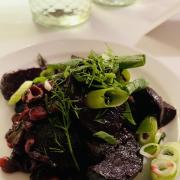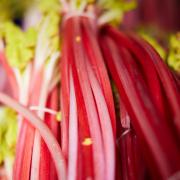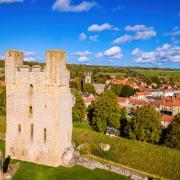How an unassuming Dales’ dairy producer has become the cream of the crop

Wensleydale Creamery is not in the middle of nowhere but it certainly shares the same postcode. Don’t let its rural location fool you though. It might be tucked away behind the miniature Dales market town of Hawes in the ample cleavage of Buttertubs and Fleet Moss, but this thriving Yorkshire business is at the very centre of the UK’s dairy industry.
This is the creamery that brought us the now iconic Wensleydale Cheese (yes, that one Gromit), was the first to add cranberries 20 years ago, attracts 250,000 visitors a year, has won more than 400 awards and has just completed a £5m expansion to double its footprint and potentially quadruple its output.
On the morning of our visit, the lads are hand-cutting five tonnes of cheese in seven vast vats. It is still predominantly men who carry out this part of the process as mixing, salting, turning, cutting and shovelling tonne after tonne of cheese is back-breaking toil.
This should become a little easier in the new adjoining creamery – a much-needed extension to the already successful Hawes operation – as the vats will be largely automated. But there will still be plenty for the highly trained cheese-makers to do.

‘The staff will remain very hands-on, checking the acidity levels and ensuring the curd is scalded at just the right temperature,’ said marketing manager Sandra Bell. ‘All our staff know to treat the curd with respect from start to finish. You have to be gentle and respectful if you want the best cheese.’
For those of you who don’t make your own cheese on a daily basis, perhaps we should briefly run through the process used in Hawes. It begins with fresh milk brought in daily from around 45 local farms, each providing somewhere in the region of 1,500 litres. This is then mixed in vats with rennet and a starter culture (made daily) until it reaches a precise level of acidity, depending on what cheese is being made, and salt is added.
While all this is going on, the milk goes through a magical array of texture transformations. First, it partly solidifies into a pleasantly wobbly white jelly. It’s then separated by giant circling paddles into curds and whey (a bit like cottage cheese) and steam is injected to scald the curd (Red Leicester has a scald temperature of 38 degrees, while Wensleydale needs 33). Next, the whey is drained away and the burly vat-watching blokes step in to cut the curd into large rectangles (like cheesy breeze blocks), which are turned over at regular intervals. And finally, once the salt has been thrown in by hand, the blocks are rapidly sliced into smaller chunks with large knives and the whole lot is shovelled into moulds (that’s half a tonne of muscle-pinging shovelling per vat).
Yorkshire Wensleydale cheese, which achieved PGI status (Protected Geographical Indication) in December 2013, has been produced in the dale in much the same way since the 12th century. It began with a group of peckish Cistercian monks, was tweaked by local farmers’ wives and was eventually produced on a large scale by Hawes first creamery, built in 1897.
The 1930s’ depression nearly saw off the business, but it was rescued by Kit Calvert, who drummed up support in the town hall and now has a cheese named in his honour.
The creamery hit trouble again in 1992 when Dairy Crest, a subsidiary of the Milk Marketing Board, decided to close the Hawes plant and transfer production to Lancashire (Wensleydale cheese being made on the wrong side of the border – makes you shudder, doesn’t it?).
Thankfully, a group of workers stepped in, agreed a management buyout and reopened the Dales operation. Current managing director David Hartley was one of those savoury saviours and he’s rightly proud of what the company has gone on to achieve.
It now turns over around £26m a year and is enjoying the spoils of a rapidly growing export market, which makes up about 14 per cent of its retail sale and includes outlets in Canada, the Far East, New Zealand, Australia and the US which, in a coals to Newcastle style, is where they source their cranberries from in the first place.
‘There’s a growing interest in this country and around the world in traditional artisan cheese,’ said David. ‘It’s got a very strong, loyal following. But it’s not easy, especially with the rise of the discount stores, and it’s a very competitive market.’
Wensleydale seems to be more than holding its own though, leading the market in a number of fields from traditional artisan to contemporary blends and premium blues.
David takes the time to show us the maturing room, where Wensleydale Blue develops its inky veins and rich, creamy flavour. The area is kept at a cool 10 degrees – any colder and the mould stops developing – and has a distinctive aroma of both ammonia and mushrooms (a combination that, thankfully, is not reflected in the resulting cheese).
‘You can teach someone to make cheese in a matter of weeks, but to build the experience to expertly grade the cheese takes years,’ said David, skewering a truckle with his cheese iron and giving us all a sneaky taste.
‘We start with the very best milk and I want people to taste that in the end product. Some cheeses can be brittle and crumbly with a dry mouth-feel, but we want crumbly and creamy. It’s a more difficult combination, but well worth the effort.‘True Wensleydale cheese reflects the Dales countryside. It’s not just about its colour and texture, it’s about our relationship with the community as a whole.’
It might seem like asking a father to choose between his children, but we have to ask: which is David’s personal cheese choice?‘It might sound boring but I love Wensleydale or Kit Calvert on oatcakes,’ he said. ‘I’m a straightforward man and that’s the way I like it.’
The new creamery, which provides around 12,000sq ft of extra space, will enable the business to produce even more Wensleydale, Kit Calvert and any number of other local cheeses.
‘It’s been designed to fit in with the location and will enable us to be greener than ever,’ said David. ‘There was talk of us relocating, but we belong here in Hawes.’
These are great days indeed for Wensleydale Creamery and it would be all too easy for the staff to sit back, put their feet up on milk churns and smile like a smug clowder of cats that got the cream. But that’s not the way things work here. The staff always have their thinking caps on (over the top of their very fetching hairnets) contemplating the next big thing.
They recently launched the UK’s first pre-sliced crumbly cheese, because life is obviously now far too frantic for us to slice our own, and are toying with a number of new ingredients to throw into the dairy mix in a bid to give cranberries a run for their substantial money.
‘These are very exciting times indeed,’ said David. ‘I’m not sure whether I’m supposed to tell you but we’re actually experimenting with yogurt at the moment. That’s going to be a whole new experience for us.’
And a whole new story for us next time we happen to be passing through Hawes and get a hankering after something delightfully dairylicious.



























